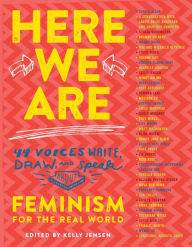The suffrage movement in the early 20th century was about giving women the vote. The feminist movement of the 1970s, beginning with Betty Friedan’s The Feminine Mystique and cresting with the Roe v. Wade decision, was about expanding women’s career opportunities. The latest women’s movement, sparked by the election of Donald Trump, is about . . .
Well, that’s a bit of a head-scratcher. After marching to the polls in 1920, marching to the Planned Parenthood clinic in 1973, marching out to work in hard hats and combat helmets, women are now just marching because. The worldwide demonstration last January that called out literally millions of marchers was gleefully proclaimed to be the start of something BIG. But, as critics remarked at the time, the participants didn’t seem to have a focus and couldn’t articulate precisely what they were mad about. They were just mad. A march with lots of signs, chants, and yelling is a great way to blow off steam, but it’s terrible for a sustained movement. The “Day without Women” on March 8 came and went without many people noticing. A second big march, tentatively scheduled for April 15, somehow turned into Make Trump Show His Tax Returns demonstration—perhaps revealing that the new wave was all about Trump, after all.
Still, the movement is coming for your daughters (and sons), and the book industry is fully  behind it. Here We Are: Feminism for the Real World is a handbook for high school teens edited by librarian and book blogger Kelly Jensen. In it, “44 voices write, draw, and speak” about the challenges still facing women today and the swell of recent history that’s on their side.
behind it. Here We Are: Feminism for the Real World is a handbook for high school teens edited by librarian and book blogger Kelly Jensen. In it, “44 voices write, draw, and speak” about the challenges still facing women today and the swell of recent history that’s on their side.
In the Introduction we’re told that feminists come in all colors, shapes, creeds, genders and cross-genders, nationalities, and preferences. “What unites feminists is the belief that every person—regardless of gender, class, education, race, sexuality, or ability—deserves equality.” It’s about “embracing differences and encouraging change that benefits all facets of society.”
In these pages we hear from transwomen and transmen, the happily married and happily divorced, lesbians, singles, artists, and journalists, but the voices are not at diverse as advertised. Author Kody Keplinger writes about choosing not to have kids (she just doesn’t want them, okay?), but no one writes about the uniquely feminine joys of motherhood. “Reproductive rights” are supported almost casually, as a principle no reasonable person would dispute, while there are no reasoned arguments for life. Muslim blogger Kaye Mirza extols her feminist-inspired faith, but no Christian explores defining feminism in Christ. “Embracing differences” is true only up to a point; the differences embraced are about preference, not conviction. As far as conviction goes, these voices are all on the same page.
But that’s only to be expected, in a volume showered with starred reviews from the secular media. I don’t blame the editor or writers, who just assume they are nicely diversified and on the side of the angels. How many have ever even sat still for a reasoned argument of the pro-life position or biblical complementarianism? Probably none, because reasoned arguments aren’t much in vogue, only emotional appeals and crude caricatures.
Here are my main takeaways from this book: 1) “Feminism” now means anything as long as it’s progressive. 2) White guys can ride along only if they admit their privilege and move to the back of the bus. 3) Female means oppressed. “Every woman, cis or trans, experiences gender inequality, discrimination or violence, but the ways they experience it differs because of factors like race, class, disability, or gender presentation.” 4) But have fun with it anyway, and explore your prurient side with creative outlets like fan fiction, where predominantly female writers get to create pornographic scenarios for their favorite fictional crushes.
Above all, 5) Identity matters more than anything—literally anything, including health, well-being, and common sense. In a chapter on “Body and Mind” Anne Theriault writes about her experiences with depression and anxiety. Amid some good advice, like refraining from isolation and choosing relevant role models, she drops this:
You get to decide how you identify. If you’re dealing with mental health issues but don’t consider yourself to be mentally ill, that’s cool. If, on the other hand, you feel like mental illness makes up part of what you are, that’s cool, too. If you want to self-identify as crazy or mad, that’s totally fine.
And that’s totally crazy. But I suspect that Here We Are is actually where we are in many high school and social media circles.
Meanwhile, reality bites. Pornography has exploded with internet technology, especially on smart phones. Sex trafficking plagues the American heartland. Girls still obsess over their looks, weight, and hotness while boys continue to take advantage of them. Fathers are too often not around to protect and affirm and mothers are distracted, wondering if they are any happier than their mothers. Women-centered feminism, generally, hasn’t made us happier; perhaps that’s why the movement is morphing to identify-centered feminism, where what you feel is what you are.
Our children (not just our daughters) need to be intentionally taught about things we used to take for granted, like biological sex and problematic feelings. Above all, we need to discuss identity with them: is it based on how we feel, or something outside ourselves? Is identity the same as selfhood? Do we get to shape who we are, or do agents beyond our control–like family, geography, history, and biology–play some part in that? Above all—
Who made you? God
Why did God make you and all things? For His own glory.*
Locating our identity in Christ is the only antidote to the candy-flavored poison of identity culture.
________________________________________________
*Westminster Children’s Catechism, Questions 1 & 3
Stay Up to Date!
Get the information you need to make wise choices about books for your children and teens.
Our weekly newsletter includes our latest reviews, related links from around the web, a featured book list, book trivia, and more. We never sell your information. You may unsubscribe at any time.
Support our writers and help keep Redeemed Reader ad-free by joining the Redeemed Reader Fellowship.
Stay Up to Date!
Get the information you need to make wise choices about books for your children and teens.
Our weekly newsletter includes our latest reviews, related links from around the web, a featured book list, book trivia, and more. We never sell your information. You may unsubscribe at any time.
We'd love to hear from you!
Our comments are now limited to our members (both Silver and Golden Key). Members, you just need to log in with your normal log-in credentials!
Not a member yet? You can join the Silver Key ($2.99/month) for a free 2-week trial. Cancel at any time. Find out more about membership here.
6 Comments
Leave a Comment
You must be logged in to post a comment.




I have not heard of this book and would not feel comfortable criticizing it without reading it first. But, I am so concerned about the prevalence of complacency in our society. As it says in Jeremiah, “the human heart is deceitful above all things,” and if we rely on what “feels good,” we forsake the truth. When big celebrity names are endorsing marches and things that, in actuality, are accomplishing nothing, it sends a message of superficiality. Girls learn brashness and feel that they can act any way they choose just because it is the socially acceptable thing to do. I worry for my young nieces and pray for them daily.
Thank you for this interesting review.
Meredith,
You’re so right–girls are basically being coached to act like boys and vice versa, with no regard for the inborn tendencies of both. At the risk of sounding my age, Nothing good will come of it.
i love this, thanks! Do you know of any books or fairy tails that you thing will help to start these discussions?
Good question! Basically any fairy tale that turns on self-sacrifice can help. See our Beauty and the Beast devotionals and book suggestions!
My 16 y.o. daughter is calling herself a “feminist” and says that I, as her mother, do not understand her or the current feminist culture. We are a pretty strong Christian family attending a CCS, so she is not without voices to guide her with wisdom. (She is dabbling in rebellion and is veering into dark themes right now as well.) My husband suggested that she and I read a Christian world-view book together to help us talk about this subject. Do you have any recommendations? Thank you for your important work.
Lori–Thank you for getting in touch with us! I suspect your concern is increasingly common. I myself went through a rebellious phase MANY years ago, but the culture wasn’t so hostile to Christianity then. I would suggest you look up Confronting Christianity by Rebecca McLaughlin. She addresses the most virulent charges the current culture hurls against Christianity with grace and intelligence. If nothing else, it should stimulate some good discussions. Praying for you!